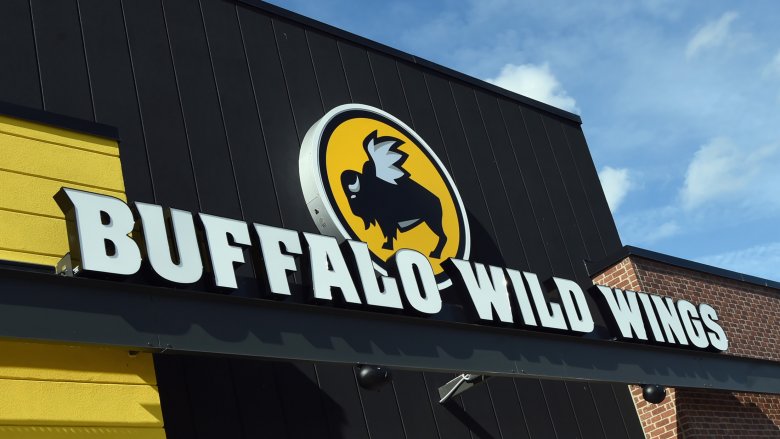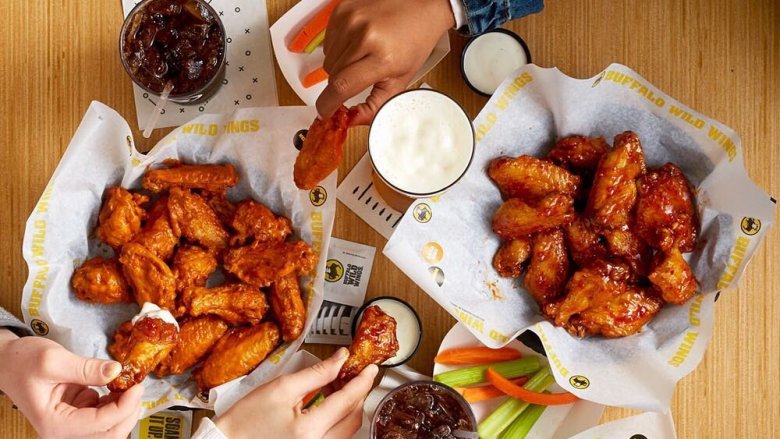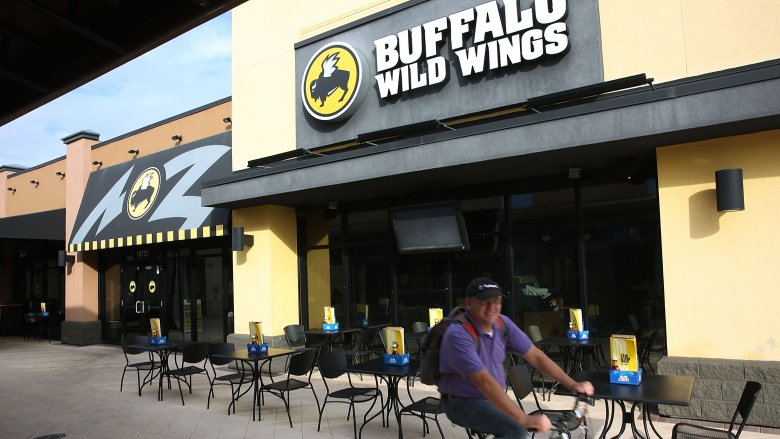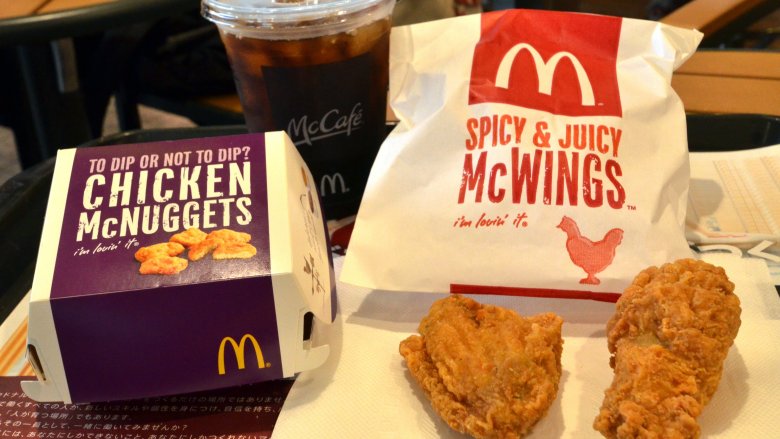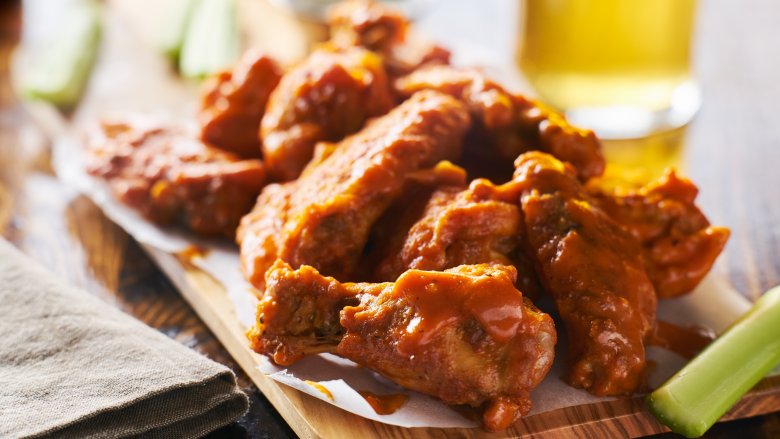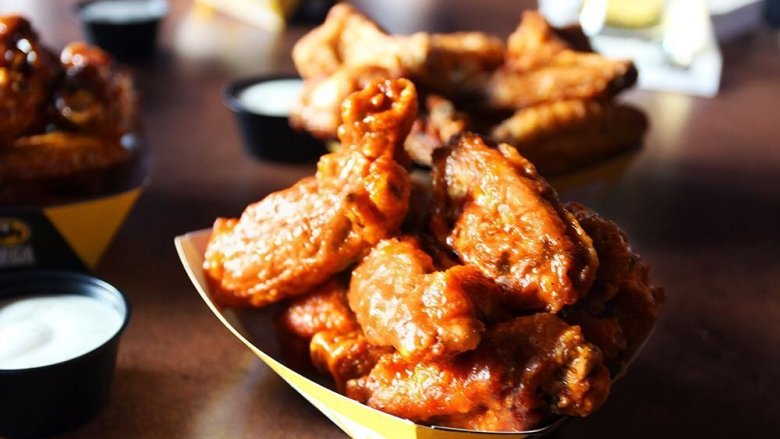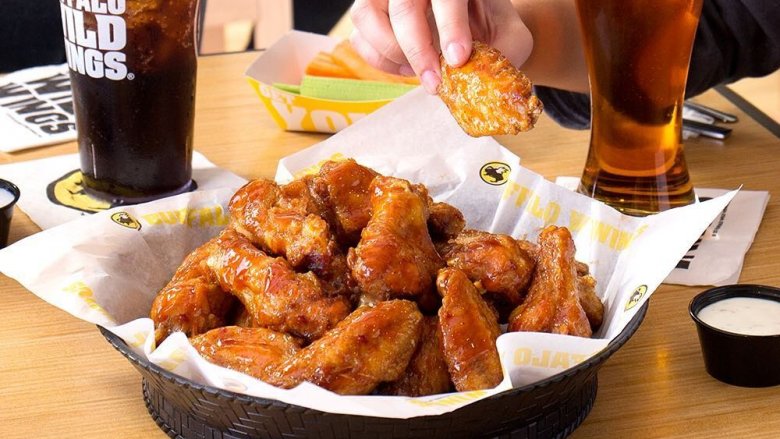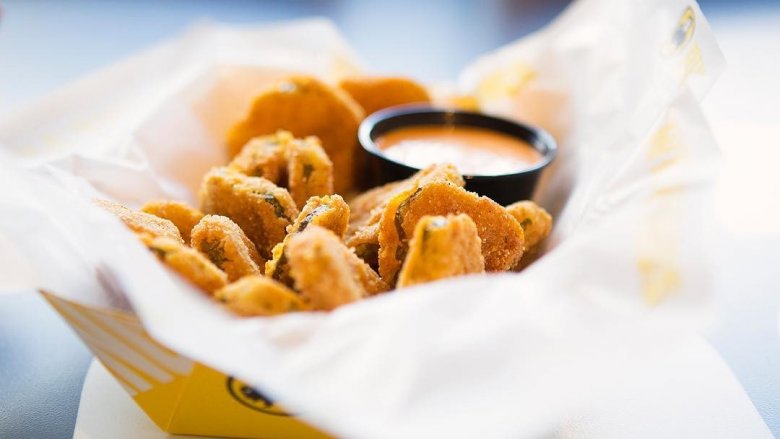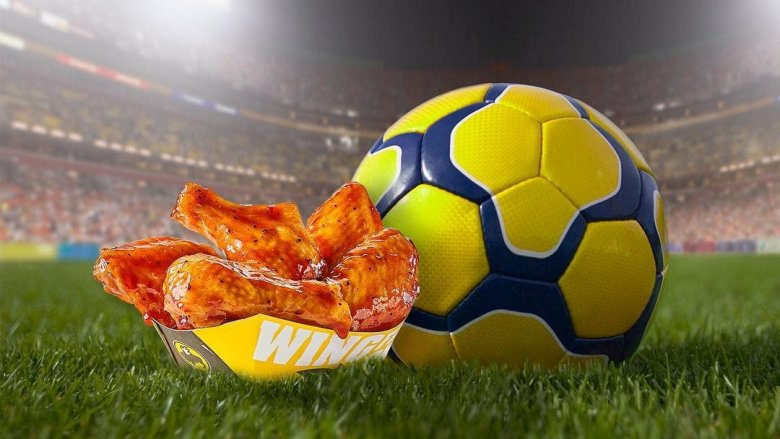The Real Reason Buffalo Wild Wings Is Struggling
At a glance, it seems like basing a restaurant solely around chicken wings and beer is a winning combination. Wings are delicious, versatile, and historically cheap, and beer? Beer is amazing.
That's why it's surprising that Buffalo Wild Wings is struggling. They seem to have all the elements of a successful business plan: fun food, sports, and an environment that's perfect for meeting a group of friends and just hanging out there. But in 2017, BDubs announced they were starting to sell company-owned locations to franchisees.
According to Nation's Restaurant News, the sale wasn't just corporate's idea, it came because shareholders were starting to put the pressure on. Sales were slumping, and profits were down — and when the shareholders aren't happy, no one's happy. When the announcement was made, things were still pretty up in the air about the fate of some of these failing restaurants. Let's talk about just why they're having such a tough time.
Chicken prices are rising
In late 2017 — months after Buffalo Wild Wings announced they were going to be restructuring, and almost immediately after Roark Capital made a takeover offer — Business Insider reported that their entire future rested on something out of their control: the price of chicken wings.
And that's terrifying for any business. When they released their 2017 earnings forecast (via Business Insider), they cited the rising price of chicken wings as one of their biggest problems. At the time, they were paying an average of $2.16 per pound. Compare that to the previous year's average of $1.72, and you can see how that would start to cut into their bottom line. BDubs went into damage control mode, ending half-price wings Tuesday and replacing that with a boneless wings promotion they hoped would stop the bleeding caused by their increased product costs.
And it's impossible to tell what's going to happen to those chicken prices in the future. It's unclear if they'll keep going up, go down, or if current prices are a new norm. That makes it pretty hard to solidify a business plan.
The company is too involved
In 2017, one shareholder wasn't just putting pressure on BDubs, he was taking seats on the company's board. According to the StarTribune, Mick McGuire of Marcato Capital Management made a move to seize three seats on the board — and he got them, around the same time their CEO resigned.
At the time, the company owned about half of their 1,250 locations, and that's a lot to keep track of. McGuire stepped onto the board and brought the argument that they should only own about 60 restaurants, and the rest should be sold off to franchisees.
Not long after, the company announced they would sell 83 locations to franchisees. Just what is going to happen to the rest of the company-owned locations is still unclear, but BW3s did note they were afraid selling too many properties at once would flood the market and lower their value. It's possible you'll see more franchise opportunities come up in an attempt to give locations more hands-on control.
There's more competition
While the rising cost of chicken wings is a problem in itself, it's also the consequence of another one of the problems facing Buffalo Wild Wings: competition. Since BW3s opened, chicken wings have only gotten more and more popular — and they're not the only game in town. Customers have a ton of places they can get their chicken wing fix, from pizza places to other chicken wing chains like Wingstop.
In 2017, The Wall Street Journal (via Delish) took a look at what was causing the rise in chicken prices, and they simply attributed it to more restaurants putting them on the menu. That increased consumption has lead to a shortage — which means the ones available won't come cheap. Restaurant Business devoted an entire feature to the "most craveable chain wings," and it illustrated just how many chains are doing not just what BW3s is, but sometimes more. And that's a big problem for BDubs.
More people are just making wings at home
Let's face it, there's nothing actually complicated about making chicken wings at home. Creating authentic Buffalo wings is a surprisingly easy process. They're great for saucing with whatever you have in your fridge, and thanks in part to all the delicious ideas we see on social media, more and more people are opting to give places like BW3s a miss, favoring the homemade version instead.
The Telegraph did a survey in 2013, and found the sale of specialty home kitchen equipment had skyrocketed. They said it was largely because people are rediscovering how gratifying it can be to cook. The Wall Street Journal (via Delish) says the increase in chicken wing prices is, in part, because more grocery stores are stocking fresh and frozen wings to meet the demand of home cooks, and that means entire families aren't going out and spending the money they once were at Buffalo Wild Wings.
They're insanely unhealthy
People are getting more aware of what they're putting into their bodies with each meal, and just one glance at Buffalo Wild Wings' nutritional guide is enough to make you put down the wings and grab some celery and carrot sticks instead.
Let's start with a basic, small serving size of wings, and note that this doesn't include blue cheese, seasoning, or sauces. That small order of wings is going to set you back 1000 calories and 51 grams of fat. If you add sauce (and who doesn't), you can tack on as many as an extra 310 calories and another 30 grams of fat. That's for the Thai curry option, and it's the worst of a lot of bad choices.
But wings don't have to be terrible. SFGate says that by cooking them on the grill or in the oven instead of in oil, and opting for sugar-free sauces that use a vinegar or mustard base, you can cut out a lot of the bad stuff. When you can get all of the taste and none of the guilt from the comfort of your own kitchen, is it any wonder people are staying away?
They've been a bit stagnant
In early 2018, Inspire Brands — which also owns Arby's — took a $2.9 billion chance on Buffalo Wild Wings. That's a huge investment, and when the chain's new CEO stepped up to tell everyone what problems would be fixed, he said he was going to start with the biggest: a lack of anything that set it apart from all the other places doing chicken wings.
"I think that if you look back when Buffalo Wild Wings was really, really, really successful, it was really the only one out there doing what it was doing," Paul Brown told Business Insider. "... then more competition has come in, and I think some of that competition has been a little bit more innovative."
So, they'll turn to the example Arby's set when they reimagined their image, and do the same thing to BW3s. One of the biggest things Brown says they need to do is overhaul their menu, which has been largely unchanged for too long. He says they need to offer customers something they can't get anywhere else, and by extension, a reason to go there.
Casual dining is out
By now, you've probably heard about how millennials are shunning many of the restaurants their parents and grandparents made popular. That's places like Outback Steakhouse and Applebee's, and it's an attitude that's been felt across the industry. Former Buffalo Wild Wings CEO Sally Smith was the one to call them out (via Business Insider) on the shift in their dining preferences, in a 2017 letter to shareholders.
She cited the millennial generation's tendency to gravitate toward fast-casual restaurants, delivery services, and cooking at home as the reason for the struggles not just of BW3s, but of that sector of the industry. And she was onto something. Analysts told BI that they were hard-pressed to find any casual dining chain that was thriving in the face of the cataclysmic shift across the industry. BW3s new CEO, Paul Brown, says (via Business Insider) that they'll definitely be looking at what it's going to take to get these customers in the door, and they're going to start by talking to franchisees to get their thoughts on everything from mobile ordering options to configuring restaurants to cater to delivery and takeout options.
They were slow to serve lunch
Developing a business model for a restaurant is tricky business, especially when you're banking on a menu as narrow as the one at Buffalo Wild Wings. According to The Motley Fool, there's something else at work here, too. Not only is their menu very narrowly focused, but for a long time, their target crowd was, too.
For a long time, dinner made up around half of their targeted business. Lunch, late-night, and happy hour sales were largely neglected, and that's a shame — those are the perfect times for grabbing a quick order of wings and a beer. It wasn't until 2015 that they introduced their Fast Break lunch menu and their guarantee of fast, mid-afternoon service. It wasn't until 2016 that they started really pushing their Happy Hour menu in wide-reaching promotional campaigns. It seems a huge oversight, really, and it turned into a new business strategy The Motley Fool says "should be a given".
They're too reliant on sports
In 2015, Fortune ran a feature on what a brilliant idea Buffalo Wild Wings sports bar was. In theory, it's great. It's a place where people can gather, hang out for as many hours as the game lasts, and order a steady stream of beer and wings. That turns a traditional restaurant model — one where table turnover is key — on its head, and it worked for a while.
But then sports — particularly football — started to take a nosedive in the ratings. According to Nation's Restaurant News, NFL ratings for even playoff games dropped by 5.3 percent in 2017, and that's a lot of customers who would rather stay home on a Sunday afternoon and stream their favorite 90s sitcom instead of watching the game. They said it was a warning for sports-centric chains like BW3s, and it's something they'd been through before. A late start to the football season in 2015 was blamed for slipping business, says Business Insider, and at a time when more and more people are either turning away from big-league sports or choosing to watch them at home, it may be time to rethink their strategy.
